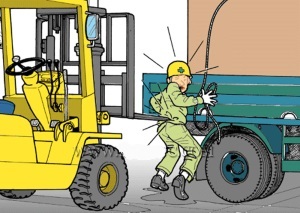Forklift Feature Articles


Are you up to date on forklift safety?
Tim Waples is chief executive of the Fork Lift Truck Association and asks if you are up to date on safety in the following article.
There are always ways that any business can improve its operations to minimise risk of accidents and protect both staff and the bottom line. Importantly, improving safety on site needn't be expensive. There are plenty of measures and methods a company can take that are low cost and easy to implement.
During our 2020 Safety Drive campaign, we looked at a number of key areas of safety that owners or users of materials handling equipment can reference. The UK is often recognised as having some of the highest safety standards in the world, but the tips we covered during Safety Drive are often universal. Almost all can be easily sourced and utilised no matter where you operate - it is simply a case of selecting what is most relevant for your site and circumstances.
Enhance your truck
If you are looking to buy a new truck, there are more optional features now available with the specific aim of improving safety. Many of these can also be retrofitted to existing trucks, making it easy to update the equipment you already have. It is worth exploring what is available, especially if it has been a while since you were last in the market.
For example, weight limiters will ensure that operators only lift and shift the correct loads, while height limiters prevent collisions with suspended elements such as pipes and ventilation systems by stopping the lifting mechanism. Speed limiters are also available, which prevent travel that is too fast while also helping to improve driving standards and fuel efficiency. Reverse camera systems are effective as they can scan the area and alert the driver to nearby hazards. More sophisticated versions even offer automatic brake intervention.
Trucks can also be easily updated by fitting them with spotlights which project a spot of light onto the floor to indicate an approaching vehicle. Similarly, a red light 'safety zone' projects lines of red light onto the floor around the perimeter of a truck, alerting pedestrians nearby to keep a safe distance. All are especially useful where blind corners are involved, or where noise levels are high, and the pedestrian cannot hear an approaching vehicle.
Adding access control keypads with designated codes, smart cards and tracking devices to your forklift will also reduce risk of unsafe operations, as they can prevent unauthorised use, and can form part of an integrated system that reports on poor or dangerous practice and collisions.
Invest in training
During our Safety Drive, training was the first subject we covered, as it should always be your first priority. This is because no matter what features your truck has, it must always be operated safely. The only way to ensure this is to train operators to complete their tasks in accordance with best practice guidelines. This means training not only the operator but, ideally, also the pedestrians who work alongside the trucks.
Manager training is equally important, so those responsible for overseeing operations are confident in how to effectively assess the workplace, control risks and improve the safety awareness culture on site.
Check site layouts
Keeping your site layout up to date is essential given how much things can change as years go by. Make a point of regularly assessing every area of your site to see where improvements can be made. For example, pedestrian segregation is of key importance, as every year many pedestrians and forklifts are involved in accidents, often with life-changing consequences.
It is best to physically separate trucks and pedestrians using barriers or elevated walkways. If this is not possible, have clearly marked footpaths that are a good distance from where forklifts operate. Support this with plenty of signs and warnings around the site. Simply ensuring that the site is well lit, particularly at crossings and pathways, will also improve visibility between pedestrians and vehicles.
Find the right fuel
If you have predominantly indoor operations, electric trucks will be safer as there are no dangerous emissions to harm operators or contaminate your products. Traditionally powered by lead acid batteries, an increasing number of models feature a lithium-ion power source. Although more costly to manufacture, lithium-ion batteries are faster and easier to charge, are maintenance free, and there is no risk of leaking acids or gases.
If you have lead acid battery-operated trucks, make sure that you have designated battery changing areas with good ventilation. Battery storage areas should be clearly marked and surrounded by barriers to protect from collisions or kept in a separate room. The floor in these areas must be flat and acid resistant. There should also be nearby access to water for neutralising spills. Only trained personnel should charge and change batteries, and they must wear appropriate PPE for these tasks.
We have seen throughout this year just how possible it is to adapt, and there is no reason we cannot apply this lesson to maintaining safety in materials handling operations. Whether you make big changes or small ones, you can make a significant difference.